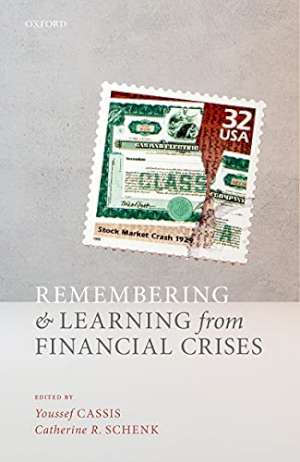28 March 2022
Remembering and Learning from Financial Crises
Edited Youssef Cassis and Catherine Schenk
2021, Oxford University Press, 206 pages,
ISBN 9780198870906
Reviewer: Rosemary Connell

This collection of contributions from 12 authors covers financial crises in Western Europe and USA from the early nineteenth century to the late twentieth century.
The book debates three main questions: Are financial crises remembered? Have lessons been drawn from them? Have past experiences been used to make decisions as new crises arise? The authors do not necessarily discuss all these questions in their contributions.
This collage of essays is very well researched and there are extensive references and bibliographies. Each chapter provides a variety of arguments and points of view. However the book is inconclusive as to whether past experience is a useful guide to the handling of future crises.
Cassis and Schenk analyse the contributions of the press to the memory of the Great Depression. They cover a number of countries and note that the press have little or no data about what knowledge bankers and politicians possessed on the Great Depression.
They also conclude that other crises such as the Debt Crisis of 1982, from which lessons could be drawn, are largely forgotten.
Schonharl discusses the political use of memories based on the Greek debt crisis of 1893. Greek memories of the crisis tended towards the unjust treatment by foreign influences whereas Germany viewed harsh European control as a route to Greek recovery.
Telesca deals with the UK’s departure from the Gold Standard in 1931 and the subsequent political tensions. Myths of betrayal and incompetence were portrayed and these themes were used in the decisions of the Labour government not to devalue in 1964 and then to devalue in 1967.
Schenk also analyses how the 1931 Sterling crisis was used for political purposes and provides two examples to demonstrate how the crisis was used as a parable and as an inspiration for practical lessons.
Larsson and Lilja show how the past was used to develop financial regulation in Sweden. In the period 1905-1935 the Swedish economy was volatile. After the Kreuger crash of 1932 regulatory measures were seen to be important and the period 1935-1985 was relatively stable. A new financial regulatory regime was developed in the 1950s. Then followed a period of deregulation in the 1980s followed by the 1990s crises. The authors analyse how these crises were handled together with the 2007-2009 crisis. They conclude that there are some common ways of handling crises and lessons can be learnt from the past
Fear and Kobrak show that different lessons can be drawn from the same crisis. Using the responses of the USA and Germany to the 1873 crisis they demonstrate the different responses by the banking and financial regulators. Corruption and scandal were important in both cases.
Quennouelle-Corre delves into the collective memory of the 1987 US stock market crash with prices falling across the globe. Memories of this crisis are shown to be vague or non-existent in public opinion; fragmented and partial for economists and historians. Twenty years later, following the 2007 crisis, a new version of the crash was put forward.
Barnes and Newton focus on organisational memory, demonstrating the distinction between commemorative and cultural memory using two prominent British Bankers, Daniel Robertson of the National Provincial (now Nat West) and George Rae of the Wales Bank (now HSBC). Both taught the value of caution in finance and put strong governance systems in place and instituted new internal accounting and reporting systems. Rae was also involved in the formal education of bankers. Rae is remembered at HSBC with a room named after him. Robertson is not well remembered at Nat West partly due to how memories were stored.
Whether or not the past can be a useful guide to handling future crises is unclear. The contexts of all crises will be different. Politics often plays an important part. Currently following a pandemic, war, inflation and possibly famine, this book may spark some ideas for dealing with crises.
This is a densely written book blending financial histories and memory studies. It draws on original interviews and a wide range of archival resources. The editors have provided data on a range of financial crises some remembered, some forgotten, some dismissed.
